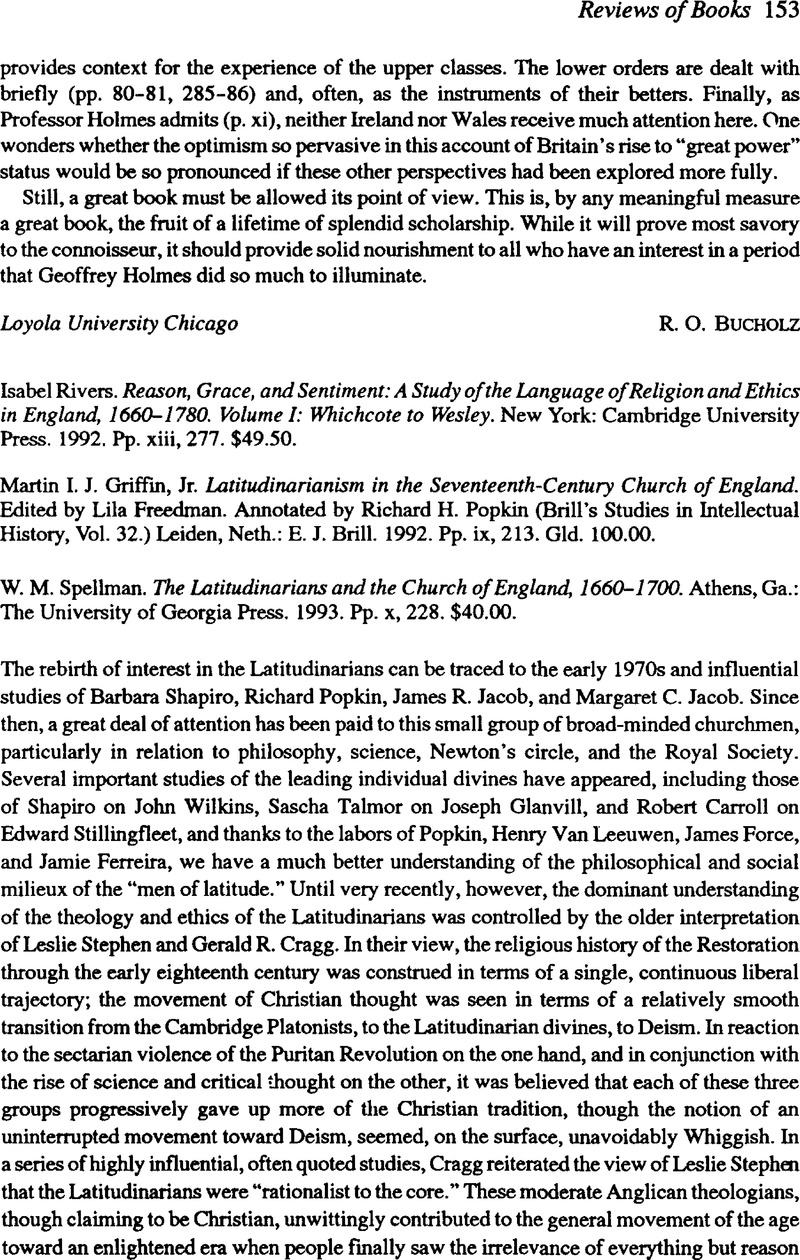Published online by Cambridge University Press: 11 July 2014

1 Especially in Cragg, Gerald R., From Puritanism to the Age of Reason (Cambridge, 1950)Google Scholar; Reason and Authority in the Eighteenth Century (Cambridge, 1970)Google Scholar; The Church in an Age of Reason (London, 1980)Google Scholar. The general Whiggish thrust of an unbroken movement toward reasonable religion can be traced back in essentials to the works of Tullock, John, Rational Theology and Christian Philosophy in the Seventeenth Century, 2 vols., (Edinburgh, 1872)Google Scholar; and SirStephen, Leslie, History of English Thought in the Eighteenth Century, 3rd ed., 2 vols. (1902; New York, 1962)Google Scholar. See especially, 1: 76-77.
2 For example, in the works of Jacob, Margaret C., The Newtonians and the English Revolution (Ithaca, 1976)Google Scholar, though theology was not the focus; Jacob, James R., Henry Stubbe, Radical Protestantism and the Early Enlightenment (Cambridge, 1983)CrossRefGoogle Scholar; Manuel, Frank, The Religion of Isaac Newton (Oxford, 1974)Google Scholar, took the theology of Newton seriously. On the definitions of Latitudinarianism and the question of self-ascription and whether or not we can speak appropriately of a coherent group see, Gascoigne, John, Cambridge in the Age of the Enlightenment (Cambridge, 1989) pp. 4–6CrossRefGoogle Scholar; and pp. 40-51, 82-94 where he traces the political and institutional connections of the Latitudinarians, though not the theological, and Spun, John, “Latitudinarianism and the Restoration Church,” The Historical Journal 31 (1988): 61–82Google Scholar.
3 For which, see Jacob, James R. and Jacob, Margaret C., “The Saints Embalmed. Scientists, Latitudinarians, and Society: A Review Essay,” Albion 24 (Fall 1992): 435-42CrossRefGoogle Scholar, though the essay examines principally the collection of articles edited by Richard Kroll, Ashcraft, Richard, and Zagorin, Perez, Philosophy, Science, and Religion in England 1640-1700 (Cambridge, 1992), mentioned belowGoogle Scholar.
4 A vigorous debate has recently exploded over the general nature of Georgian Anglicanism, and some aspects of the discussion have a direct bearing on the question of ethics and religion. The argument was sparked afresh by a 1989 article of Scholtz, Gregory F. entitled “Anglicanism in the Age of Johnson: The Doctrine of Conditional Salvation,” Eighteenth-Century Studies 22 (Winter 1988-1989): 182–207CrossRefGoogle Scholar; Greene, Donald, “How ‘Degraded’ was Eighteenth-Century Anglicanism?” Eighteenth-Ctntury Studies, “Forum,” 24 (Fall, 1990): 93–108Google Scholar; and Scholtz, , “Reply,” pp. 109-11Google Scholar.
5 Compare pp. 83-84, 87-88,98-99, with 128-29, and 133, where Griffin simply fails to reconcile the Latitudinarians' emphasis on supernatural grace on the one side with moral ability on the other. On the one hand he says that they defended the idea of “supernatural assistance” in the performance of duties, and on the other, he says that their interpretation of revelation, “added nothing significant to the natural law” (p. 121). But how can supernatural assistance be nothing significant?
6 Perhaps this traditional theology is in line with other more traditional convictions. Richard Ashcraft argues that the Latiludinarians* views on toleration were severely limited. See “Latitudinarianism and toleration: historical myth versus political history,” in Kroll, , et al.Philosophy, Science, and Religion, pp. 155-56Google Scholar. Griffin makes the same point (pp. 151-52), as does Spellman (pp. 42-44). This Is certainly true, if measured by modem standards of indifference; movcover, Ashcraft is correct that rational thought meant something far different to the Dissenter (related, as it was, to the Dissenter's critique of tradition and the importance of the individual conscience) than it did to the Anglican. On the other hand, Wilkins, Burnet, and Tillotson all had Presbyterian antecedents, and it is unlikely that their tolerant outlook was as political as Ashcraft implies.
7 S. J.Reedy, Gerard, Robert South (1634-1726): An Introduction to His Life and Sermons (Cambridge, 1992), pp. 124, 150Google Scholar. See chapter six entitled “Latitudmarians and Mystery.” Differences of interpretation can be attributed at least in part to the problem of selectivity: Reedy observes that “far too much emphasis has been placed on a few sermons of Tillotson that equate religion with happiness, to the detriment of many other sermons that place harsher demands on the morals and minds of congregations” (p. 125).
8 Emerson, Roger, “Latitudinarianism and the English Deists,” in Deism, Masonry, and the Enlightenment, ed. Lemay, J. A. Leo (Newark, Del., 1987), pp. 19–48Google Scholar. Chamberlain, Jeffrey S., “The Limits of Moderation in a Latitudinarian Apologist: Or, High-Church Zeal in a Low Churchman Discover'd,” in Lund, Roger, ed., The Margins of Orthodoxy: Heterodox Writings and Cultural Response, 1660-1800Google Scholar. Alan Gabbey, “Cudworth, More and the Mechanical Analogy,” in Kroll, , et al., Philosophy, Science, and Religion, p. 111Google Scholar. “Unswerving conformability to the undoubted essentials of Christianity lay at the heart of the latitudemen's spirituality” pp. 114, 120.
9 Similarly, the careful theological analysis of James Force has shown that describing Newton as a Deist Is a great oversimplification; Force positions William Whist on, Samuel Clarke, and Newton in a third position between the Deists and the orthodox (Force, James E., “The Newtonians and Deism,” in Essays on the Context, Nature, and Influence of Isaac Newton's Theology, ed. Force, James E. and Popkin, Richard H. [Dordrecht, 1990], pp. 43–76CrossRefGoogle Scholar) in arguing against the contentions of Richard Westfall. There is indirect corroboration for these arguments in the new study by John Corrigan on the so-called catholic or latitudinarian clergy of New England. They too demonstrate that an appreciation for cosmic order, human reason, and toleration did not necessarily lead to a rejection of the traditional ideas about sin and grace. Corrigan, John, The Prism of Piety: Catholick Congregational Clergy at the Beginning of the Enlightenment (Oxford, 1991)Google Scholar.
10 Jacob, and Jacob, , “The Saints Embalmed,” pp. 437-38Google Scholar.
11 Jacob, , The Newtonians, pp. 143-61; compare, Spellman, pp. 69, 145Google Scholar.